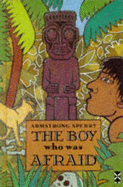HAVE
you read a novel/biography recently by a Pacific writer (or about the Pacific) in
recent times? And enjoyed it?
(This was posted in Pacific Indigenous Writers, a Facebook page.)
Two
books come to mind. Let me discuss the
first one. (I should write about the second in my next post.)
As
may have been mentioned in Pacific Indigenous Writers (PIW) sometime ago, I
read a very good book in 2008 when I was on an island in Micronesia.
The
book “The Boy Who Was Afraid” tells the story of a 15-year-old boy living with his people on
an atoll called Hikueru, somewhere in Tahiti.
Picture: Cover of the book "The Boy Who Was Afraid" - written by Armstrong Sperry.
Mafatu
was the son of the chief of the island but had this fear of the sea due to an
experience when his mother and he (when he was three) were washed out to sea in
a storm. His mother died while trying to keep him alive. They fed on dried nuts
that floated by the small rock they were clinging to.
He
was teased by the other boys because when they told stories of the big fish
they caught, he had none to tell. You see, he never went out fishing with the
boys and men.
While
his peers were fishing, he was mending fishing nets, lines and other things –
that, by the way, is usually done by old people.
He
was fearful of the sea – and also Moana, the god of the sea.
Out
of shame of being mocked often about his fear, he took a canoe, and with his
skinny companion dog Uri, sailed out to sea. He directed the canoe towards the
west. After days of battling the waves, winds and the Sun, he arrived on an
island. It had a lagoon.
Mafatu
and Uri survived on the island. The boy used the survival skills he learned
while mending the nets and lines back at home.
While
standing on the highest point on the island and looking out to sea, to the
east, he could not see his atoll. From the same vantage point, he realized that
there was another island further west. Other things on the island, like a
ritual site, somewhat confirmed what he thought - the island could be where
what his peers and people feared and talked about, a place in the west where
cannibals killed and fed on other human beings.
A
bit later Mafatu carved out a canoe from the mighty tamanu (calophyllum) tree.
He
lived on the island for quite a while until one day when canoes with men came
to the island for a ritual.
While
attempting to see what the men were going to do, Mafatu was sighted, and was
chased. Fortunately, his canoe was ready, sail and all, and stocked well with
supplies – fresh coconuts, bananas, breadfruit and fishing lines.
He and
Uri managed to escape from the men on the land. The two got on the canoe and
pushed it into the water and paddled out into the lagoon. When the men gave
chase with their big canoes in the open seas, Mafatu uttered a prayer to Maui,
the god of the fishermen, and set his canoe for the east – towards Hikueru.
Maui
answered Mafatu’s prayer and stirred up a wind that filled his sails and shot
his canoe out of the reach of the bad men.
Again,
after days and nights of battling the sea and the Sun as well his own fears
(and now without food), even to the point of almost giving in, one evening Mafatu
sighted the “special lights” over the atoll – something that all fishermen out
at sea knew would appear in the evenings.
As
the canoe made its way into the atoll’s lagoon, the whole village (including
the chief) came to the beach to see the “people” in the canoe. They could all
see that the canoe was a strong canoe, built by someone who knew how to build
canoes.
NOTE:
The
book was not written by an islander.
It
was written by Armstrong Sperry in 1961. Sperry is an American and being a former
navy officer, he spent time in the Pacific.
The book
“The Boy Who Was Afraid” is a reader for students in schools in some parts of
the Pacific.
MY
VIEWS:
I
loved the book for a number of reasons.
I
grew up near the sea and could identify with certain things. I like talking
about canoes and voyages and therefore I found the book very interesting.
Bits
of traditional sailing/navigation knowledge are also shared in the book –
things I also like.
Along
with the sea, survival skills are shared in the book – skills that are
applicable in most parts of the Pacific.
It
would be nice if more Pacific writers could write books like that – capture the
simple village life with the challenges that people there face. (If they want to
make it complicated, add a bit about how the villager tries to come to terms with
the intrusion of western ideas/life into the rural/village setting.)
The
challenge is now with you. Will you also help in recording skills and knowledge
of our people - as in the form of writing books?
Over
to you PIW members.
Cheers.


No comments:
Post a Comment